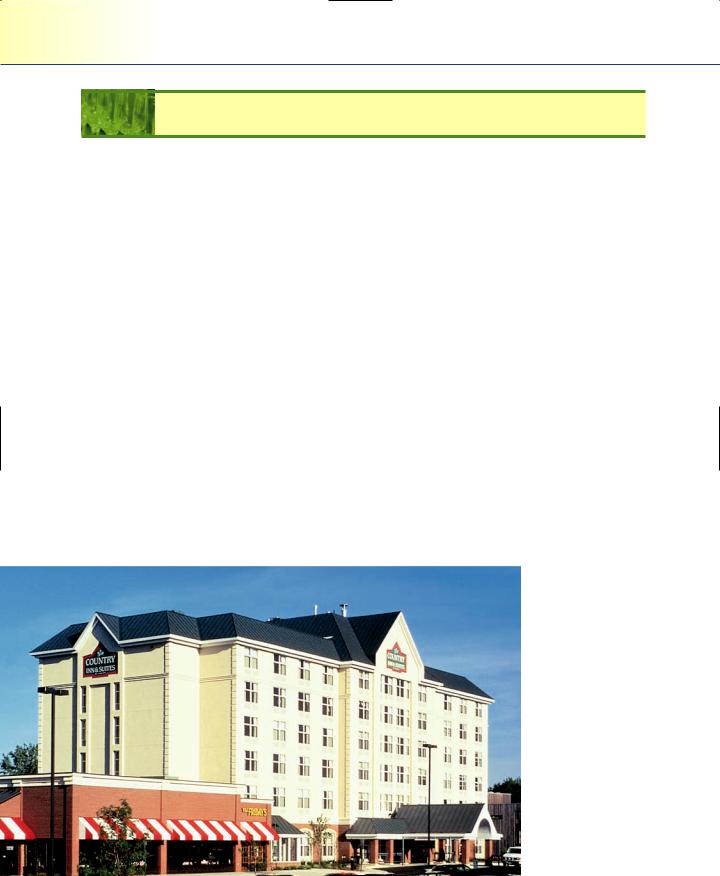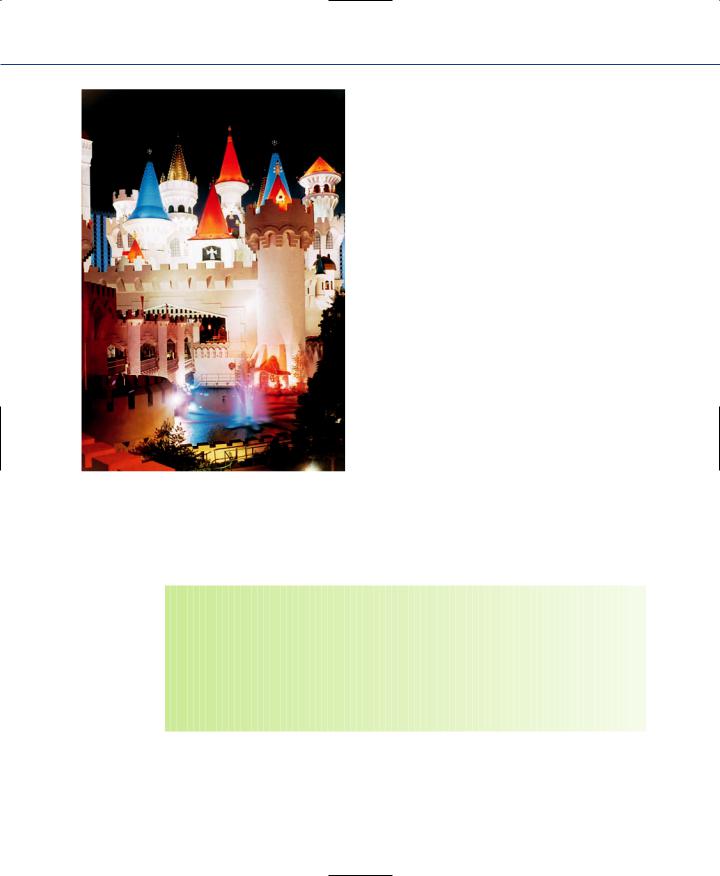
- •CONTENTS
- •PREFACE
- •Content—Benefits for Students
- •Content—Benefits for Instructors
- •Features of the Book for Students and Instructors
- •Supplementary Materials
- •Acknowledgments
- •What Is Hospitality Management?
- •The Manager’s Role in the Hospitality Industry
- •Why Study in a Hospitality Management Program?
- •Planning a Career
- •Employment as an Important Part of Your Education
- •Getting a Job
- •Employment at Graduation
- •The Outlook for Hospitality
- •Summary
- •Managing Change
- •Demand
- •Supply
- •Workforce Diversity
- •The Impact of Labor Scarcity
- •Summary
- •The Varied Field of Food Service
- •The Restaurant Business
- •The Dining Market and the Eating Market
- •Contemporary Popular-Priced Restaurants
- •Restaurants as Part of a Larger Business
- •Summary
- •Restaurant Operations
- •Making a Profit in Food Service Operations
- •Life in the Restaurant Business
- •Summary
- •Chain Restaurant Systems
- •Independent Restaurants
- •Franchised Restaurants
- •Summary
- •Competitive Conditions in Food Service
- •The Marketing Mix
- •Competition with Other Industries
- •Summary
- •Self-Operated Facilities
- •Managed-Services Companies
- •Business and Industry Food Service
- •College and University Food Service
- •Health Care Food Service
- •School and Community Food Service
- •Other Segments
- •Vending
- •Summary
- •Consumer Concerns
- •Food Service and the Environment
- •Technology
- •Summary
- •The Evolution of Lodging
- •Classifications of Hotel Properties
- •Types of Travelers
- •Anticipating Guest Needs in Providing Hospitality Service
- •Service, Service, Service
- •Summary
- •Major Functional Departments
- •The Rooms Side of the House
- •Hotel Food and Beverage Operations
- •Staff and Support Departments
- •Income and Expense Patterns and Control
- •Entry Ports and Careers
- •Summary
- •The Economics of the Hotel Business
- •Dimensions of the Hotel Investment Decision
- •Summary
- •The Conditions of Competition
- •The Marketing Mix in Lodging
- •Product in a Segmented Market
- •Price and Pricing Tactics
- •Place—and Places
- •Promotion: Marketing Communication
- •Summary
- •The Importance of Tourism
- •Travel Trends
- •The Economic Significance of Tourism
- •The United States as an International Tourist Attraction
- •Businesses Serving the Traveler
- •Noneconomic Effects of Tourism
- •Summary
- •Motives and Destinations
- •Mass-Market Tourism
- •Planned Play Environments
- •Casinos and Gaming
- •Urban Entertainment Centers
- •Temporary Attractions: Fairs and Festivals
- •Natural Environments
- •On a Lighter Note. . .
- •Summary
- •Management and Supervision
- •The Economizing Society
- •The Managerial Revolution
- •Management: A Dynamic Force in a Changing Industry
- •What Is Management?
- •Summary
- •Why Study Planning?
- •Planning in Organizations
- •Goal Setting
- •Planning in Operations
- •The Individual Worker as Planner
- •Long-Range Planning Tools
- •Summary
- •Authority: The Cement of Organizations
- •Departmentalization
- •Line and Staff
- •Issues in Organizing
- •Summary
- •Issues in Human-Resources Management
- •Fitting People to Jobs
- •Recruiting
- •Selection and Employment
- •Training
- •Retaining Employees
- •Staff Planning
- •Summary
- •The Importance of Control
- •Control and the “Cybernetic Loop”
- •Tools for Control
- •Summary
- •Leadership as Viewed by Social Scientists
- •Why People Follow
- •Leadership Theories
- •Communication
- •The Elements of Leading and Directing
- •Developing Your Own Leadership Style
- •Summary
- •A Study of Service
- •Rendering Personal Service
- •Managing the Service Transaction
- •How Companies Organize for Service
- •Summary
- •INDEX

378 |
Chapter 12 Competition in the Lodging Business |
The Conditions of Competition
The beginning of the twenty-first century was characterized by extreme changes for the lodging industry and the North American lodging industry in particular. The losses experienced by the industry were related to a weakening economy, the tragedies of September 11, the war in Iraq, and the outbreak of SARS. Unlike the lodging industry crisis of the 1990s, the challenging times starting in 2001 were not directly related to overbuilding of hotels and a surplus of room inventory. Overbuilding, however, is always a concern in terms of how it can significantly and negatively impact the industry even in better economic times such as the turnaround that started in 2003. Indeed, the increasing role of public capital markets, which we discussed in the last chapter, increases the availability of capital for possible overbuilding. The low variable cost of the industry makes price cutting in the short run tempting—and price cutting is always tempting when overcapacity is a problem. Moreover, technological changes related to where, how, and when a hotel room is sold are changing the marketplace every day. The impact of the Internet on the hotel pricing structure has been a major factor— more than ever could be imagined when hotel-related Web sites first emerged. In the
following sections, we will discuss each of these conditions of competition.
A FRAGMENTED MARKET
The facts of the marketplace are that the ownership of hotel properties is spread among a wide number of individuals and corporations. The presence of national and regional
A chain brand has come to be called a “flag.” (Courtesy of Carlson Hotels Worldwide.)

The Conditions of Competition |
379 |
hotel brands gives the appearance of a few dominant chains. Ownership in the hotel business, however, is not highly concentrated; rather, it is a highly fragmented market. A hotel brand or franchise has come to be called a “flag.” Although it is not as easy for a hotel to drop a franchise as it is to take down a flag, the analogy is compelling. In converting from a chain affiliation to becoming an independent sometimes is a voluntary move on the part of the hotel’s ownership. Sometimes, however, the chain drops their affiliation with the hotel for a number of possible reasons. It could be that the hotel’s owners did not pay the required fees to the chain. It may have involved the hotel not maintaining the chain’s standards of service or cleanliness. Franchise agreements between franchisors and franchisees stipulate in detail reasons for terminating the relationship on both the part of the chain as well as the ownership of the hotel.
The lodging industry is not static in terms of the types of hotels that may be competing against one another. The pipeline forecast included 847 new hotels opening in 2006 with 89,269 rooms and 1,084 hotels in 2007 with 119,665 rooms. The segment mainly driving the pipeline in 2006 and 2007 was the mid-market property without food and beverage. InterContinental’s Holiday Inn Express and Hilton’s Hampton Inn and Suites are front-runners of new hotels in this segment. Other strong developer favorites were Comfort Inns and Suites and LaQuinta Inns and Suites. The midscale segment with food and beverage was also up 120 percent with leaders being the Holiday Inn brand and Best Western. Of the hotels in the pipeline in 2006, 94 percent were less than 200 rooms. Of the luxury projects in the pipeline, another strong segment during that same period of time, 80 percent had some combination of private residences, condo hotel units, fractional vacation club or timeshare interests. An additional 20 percent of the luxury projects were part of major office or retail development projects.1
The supply and demand patterns are major causes of shifts in the hotel industry. Large firms have large stakes and are less likely to do something unpredictable. In a fragmented market, with many small firms seeking their own interests and survival, competition is much less predictable. When survival is at stake, as it often is in lodging, desperate measures taken by one or a few players can destabilize an entire market.
A CYCLICAL MARKET
A second condition that shapes competition in lodging, as noted in Chapter 11, is that lodging is a cyclical industry, one that has been characterized by periods of demand outpacing supply as well as supply surpassing demand. The immediate outlook for the industry depends, in large part, on where the industry is in the cycle. Generally, when overcapacity threatens an industry, pricing stability is undermined.

380 |
Chapter 12 Competition in the Lodging Business |
COST STRUCTURE
A third critical competitive characteristic of the lodging business is that it has a low variable cost in relation to sales and a correspondingly high fixed cost. A low variable cost means that there is very little cost associated with the sale of one more room. The variable cost can be as low as $5 per rented room, ranging up to $15 or $20, while the corresponding room rate might range from $30 to $120. This large margin over costs makes it easy to cut prices and still show a profit—in the short run. The temptation to cut prices is particularly strong in periods where supply exceeds demand, occupancies and revenues fall, and the need to meet the burden of high fixed costs becomes more pressing.
SECURITIZATION
Another related condition, also discussed in Chapter 11, is the growth in securitization in the industry. Securitization, by making capital more readily available to developers, makes overbuilding more of a threat. New sources of financing clearly increase the total financing available for purchase of hotels and bring an increased number of firms with deep pockets (i.e., well-financed firms) to the hotel business in all of its segments.
TECHNOLOGICAL REVOLUTION
A final factor is the impact of technology on the hotel business. Technology and the change it brings cuts across all areas of the hotel business: improving service, facilitating control of costs, heightening security, for example. As a condition of competition, however, we need to note that in the area of marketing, the technological revolution has fundamentally altered the way hotel rooms are offered for sale. The Internet has had a tremendous impact on the way hotels do business. Internet-based channels of distribution such as Travelocity and Expedia have put the hotel consumer in the driver’s seat in terms of shopping for the most competitive room rates. Finally, computerization of guest and customer prospect information makes possible the use of individualized information in planning and executing promotional plans.
Collectively, these five factors of competition describe an industry that is, on a scale of competitive to monopolistic, highly competitive. Within the boundaries of these conditions of competition, we can use the marketing mix to analyze competitive

The Marketing Mix in Lodging |
381 |
I N D U S T R Y |
I M P A C T |
C H A R A C T E R I S T I C |
|
Fragmented ownership |
Unpredictability, especially in down markets |
Cyclical |
Overcapacity exerts downward pressure on |
Periodic overbuilding |
|
Low variable cost |
|
High fixed cost |
Exerts downward pressure on prices |
Increasing securitization |
Makes capital more available for development |
Technological revolution |
Heightens role of travel intermediaries (travel |
|
agents, reservation services, airlines, etc.), |
|
adding to marketing costs and reducing |
|
control over price |
Figure 12.1
The conditions of competition in lodging
practices in lodging. Figure 12.1 summarizes the five conditions of competition in the lodging industry.
The Marketing Mix in Lodging
The marketing mix is conventionally thought of as encompassing the four Ps: product, price, place, and promotion.2 In most cases, the application of these four terms varies somewhat as one moves from industry to industry. In lodging, then, we can hardly be surprised that we need to modify the four Ps to make the concepts that
underlie them in lodging clearer.
Product, for instance, includes both physical goods and services. It also involves characteristics that are present in the individual property, such as the guest rooms, the lobby, and the amenities package, and services offered by a hotel. However, product also refers to the lodging system’s (chain’s or franchise group’s) services. Ultimately, the product the guest consumes is an experience—what happens to her or him, in its totality, during a visit.
Price refers not to some fixed rate but a price that varies with levels of demand and with customer groups served. Because there is no inventory of yesterday’s rooms, there is pressure to sell rooms each day. Alternatively, what is for sale is a fixed capacity, and so price tends to rise in periods of high demand. The truth is that the rack rate (the listed price you might find in a directory) is paid by only a small percentage of guests,

382 |
Chapter 12 Competition in the Lodging Business |
The lodging product consists of the guest’s entire experience. In Las Vegas, the Excalibur and other huge resort hotels seek to capture the guest’s imagination. (Courtesy of Excalibur Hotel and Casino.)
probably less than one-fifth. It is more realistic, therefore, to speak of pricing policy rather than just price. As noted previously, the industry is cyclical, and fixed costs tend to exert downward pressure on prices in markets where there is overcapacity.
Place, referring to the location of an individual property, is a very important aspect of the lodging marketing mix, but the places where the hotel room is sold—for instance, travel agents and other travel intermediaries—are also extremely important. This latter aspect, we will find, is also a system characteristic in chains and other lodging groups.
Promotion refers to marketing communication, generally taken to include persuasive activities such as advertising, sales promotion, and public relations. We will also include here persuasive activities such as frequent-traveler programs and other individualized means to reward customers for brand loyalty.
Figure 12.2 summarizes the lodging marketing mix as it is discussed in this chapter. In the next section, we will explore these concepts in detail in terms of market tactics.
L E I S U R E T R A V E L E R S |
B U S I N E S S T R A V E L E R S |
Value for the price |
Location of hotel |
Location of hotel |
Previous experience with hotel or chain |
Room rate |
Reputation of hotel or chain |
Previous experience with hotel or chain |
Value for the price |
Reputation of hotel or chain |
Room rate |
Figure 12.2
Hotel/Resort Selection Factors—Extremely/Very Influential in Determining Selection in 2003
Source: Peter C. Yesawich, “Business and Leisure Travelers: Is There Really a Difference? Hotel and Motel Management, November 3, 2003, p. 10.
